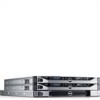Dell PowerVault NX3500 Administrator's Guide - Page 120
PowerVault NX3500, address from that list see the following comments regarding DNS
 |
View all Dell PowerVault NX3500 manuals
Add to My Manuals
Save this manual to your list of manuals |
Page 120 highlights
sure that the services continue even if a controller fails. Without being aware of the system's architecture, clients benefit from its high availability and high performance. Client users may access the system in a variety of network topologies. From a performance perspective, the important question is which subnets the clients belong to (there may be more than one) and can the PowerVault NX3500 be on the same subnets. Depending on the physical capabilities of the network infrastructure, the PowerVault NX3500: • Belongs to all LAN/client subnets, in which case all clients are considered flat. From a performance perspective, this is the most optimal configuration. In such network configurations, it is sufficient to define one client access virtual IP address (VIP) for each subnet, the same VIP that is described in Accessing the System. • Does not belong to any of the LAN/Client subnets, in which case all clients are considered routed. In such situations, the clients access the data via a router or layer 3 switches. In such network configurations it is recommended to define multiple client access virtual IP addresses in a single subnet, and provide some mechanism for clients to select an IP address from that list (see the following comments regarding DNS configuration). • Belongs to some of the LAN/Client subnets, in which case some clients are flat and some are routed. In such network configurations it is recommended to use both methods described above, and inform the users about the VIPs they need to use, depending on whether they are flat or routed. It is recommended to define an entry in the DNS for every subnet that the system belongs to, so that clients can access the data without remembering the VIPs. If there are multiple VIPs in the subnet, define a single name in your DNS server that will issue IP addresses from that list in a round-robin fashion and that all the clients access the system by that DNS name. NOTE: Never intermix VIPs from different subnets in a single DNS name. 120 Managing the PowerVault NX3500















